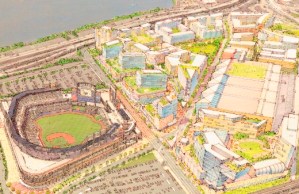 A lawsuit challenging the development of Willets Point has been dismissed by a state judge, handing the Bloomberg administration a key victory in its attempts to transform the industrial area by Citi Field into a housing and retail center.
A lawsuit challenging the development of Willets Point has been dismissed by a state judge, handing the Bloomberg administration a key victory in its attempts to transform the industrial area by Citi Field into a housing and retail center.
The lawsuit, brought by a set of business and land owners in the project’s footprint, challenged the environmental review, a common tactic by opponents of large development projects. While the lawsuits typically are dismissed for such projects, the Willets Point development is far more complex than most, and the landowners were well armed with consultants and a veteran environmental attorney, Michael Gerrard of Arnold and Porter.
In argument after argument, the court rejected the landowners’ contentions that the environmental review failed to properly account for various required items (emergency responder time; highway impact; drinking water impact, etc.).
In reaction to the news, Seth Pinsky, president of the city’s Economic Development Corporation, released a statement celebrating the win:
Today’s judgment on an Article 78 petition filed last year moves Willets Point one step closer to becoming New York’s next great neighborhood, a center of opportunity and a driver of growth for the City’s economy. It’s good news for Queens residents and the local economy, and it’s another affirmation for a project that has the overwhelming support of the City Council, local elected officials and the Community Board.
The landowners and business owners are a tenacious bunch, and there’s no reason to think they will surrender at this point, given that many have insisted they will not leave until the city forces them out with eminent domain.
Recently, they have been focusing intently on the federal approval of the off-ramps to the Van Wyck Expressway, saying the traffic numbers and the city’s application are deeply flawed. As the judge who wrote the decision, Joan Madden, noted in her ruling, the city has said it cannot proceed with the project (as currently envisioned) if it does not get federal approval for the ramps.
Richard Lipsky, a lobbyist for the business owners, played down the sting of the ruling, directing attention at the ramps.
“It’s unusual for courts to decide against the city on these kinds of challenges,” said Mr. Lipsky, who had not yet seen the ruling. “We are in the midst of having demonstrated that the city will use any deception possible in order to make the lynchpin to this project work, which are the ramps to the Van Wyck.”
Update 5:00 p.m.
Michael Gerrard, the attorney for the landowners, emailed over a response, finding some silver lining in the decision, saying it “stressed the terrible traffic effects forecast by the EIS.” Here’s the statement:
This decision is a two-edged sword for the City. It dismissed the lawsuit, finding that the environmental impact statement adequately disclosed the project’s impacts. But in so doing, it stressed the terrible traffic effects forecast by the EIS; the need for federal approval for the Van Wyck ramps; and the fact that if the ramps are not approved, the project cannot go forward. It will be interesting to see how the City will now back away from its recent claims that the project wouldn’t be so bad for traffic after all. The City can’t paint one picture to the court and a completely different picture to the federal government.


